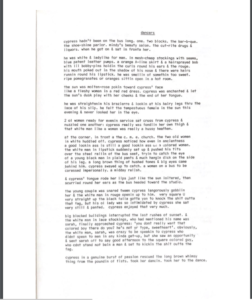intertextuality and a redefinition of an archive as a living thing (archive finds)
When Professor Hall gave us the directive to begin checking out the Ntozake Shange Papers in the archives, I had no idea what to expect. I had never been in an Archive center until then, despite being 2 and a half years into my college career. However, I went in with an open mind and little expectations of what I was going to encounter.
What struck me in my perusal of Shange’s journals and original manuscripts of poems that show up in for colored girls, was the way certain characters and her dedication to certain themes show up in her archive long before the publishing of the works that we affiliate these characters and themes with. Vani provided me with the language to reflect my perception of the way her archive and works to illuminate an active engagement with certain themes and characters throughout time. The word that she offered me to define this lineage in Shange’s published works and archive was “Intertextuality”.
Below, I’ve attached one of my favorite moments of this “intertextuality” that I found in the original chapbook of for colored girls who have considered suicide/ when the rainbow is enuf.
What strikes me about this poem, is not only the appearance of Cypress outside of a Cypress, Sassafrass, and Indigo but the appearance of Cypress in relation to queer and dance based context. As a queer woman myself, I appreciated Shange’s choice in highlighting Cypress’ queerness and it’s relationship to dance in Sassafrass, Cypress, and Indigo. However this poem reflects Cypress’ encounter with queerness or non-cisnormativity in a very different tone, with Sarah: a cross-dressing man being the center of Cypress’ attention and engagement. The way Ntozake paints Sarah and Cypress’ behavior is reflective of the times in which this poem was written and published, where LGBTQ but more specifically trans people were the recipients of large ostracization and violence in this country and often created & flocked to their own communities. Her choice in ending the poem with Cypress’ rescue of Sarah from a beat down from a black male and “[taking] her dancin”, (note, Cypress’ use of she/her pronouns rather than referring to Sarah as a man for the first time here) not only illuminates a certain tolerance of LGBTQ people and hatred of violence from Cypress but more importantly illuminates a thematic connection between dance and queerness preceeding the publishing of Sassafrass, Cypress, and Indigo.
I loved seeing the fact that Shange was thinking about and trying things with Cypress far before the publishing of her novel. This is one of countless examples of the way Shange’s publications and the Ntozake Shange Papers expand our conceptions of an archive as being a static or dead thing. She is consistently in conversation with her characters and her archive as a whole. It’s alive.
Works Cited:
Chapbook of “for colored girls who have considered suicide/ when the rainbow is enuf; BC20-29 – Ntozake Shange Papers,; Box 4 and Folder 1; Barnard Archives and Special Collections, Barnard Library, Barnard College.


